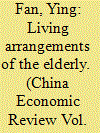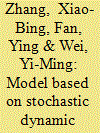|
|
|
Sort Order |
|
|
|
Items / Page
|
|
|
|
|
|
|
| Srl | Item |
| 1 |
ID:
192340


|
|
|
|
|
| Summary/Abstract |
Trade liberalization in the Regional Comprehensive Economic Partnership (RCEP) not only contributes to regional economic growth but also leads to an increase in energy consumption and carbon emissions, which may exacerbate climate change risks. This study aims to explore the carbon pricing issue in the context of the RCEP framework. Additionally, for the sake of carbon equity, we introduce a differentiated carbon pricing scheme based on the cost fairness principle (CPCF), and the unified carbon pricing was used for a cost effectiveness analysis. The empirical analysis was conducted with a global multi-regional computable general equilibrium model. The results show that with the help of trade liberalization, the RCEP's GDP, energy consumption, and carbon emissions may increase by 0.639%, 1.962%, and 1.897%, respectively. The CPCF scheme, wherein developed countries assume the primary abatement burden, can be used to offset the increase in carbon emissions from trade liberalization while RCEP members maintain positive economic growth. The total abatement cost of the CPCF for carbon offsets in the RCEP can be reduced via unified carbon pricing, and the cost-saving effect approaches 24.24%. Unified carbon pricing may result in a carbon price of US $5.83 within the RCEP. As such, this study explores carbon pricing in the context of trade liberalization, and its findings will be valuable for the RCEP to achieve a win-win situation in terms of economic growth and climate change.
|
|
|
|
|
|
|
|
|
|
|
|
|
|
|
|
| 2 |
ID:
082899


|
|
|
|
|
| Publication |
2008.
|
| Summary/Abstract |
This paper studies the internationalisation of Chinese piano firms from a branding perspective. The purpose of the paper is twofold. First, it examines the interplay between the country of origin (COO) effect and international branding, and how COO affects the choice of branding strategies in international markets. Second, it explores the possible link between international branding decisions and international expansion of the firm. A model is introduced that illustrates the relationships between COO, branding options and internationalisation. Corresponding to its progress in internationalisation, a firm's branding development in international markets may follow certain stages. As the firm moves to advanced stages, it increases its international brand equity; the impact from negative COO will decrease and eventually become irrelevant. The literature on internationalisation is largely based on the experience of MNEs from Western developed countries. Multinational firms from developing countries such as China possess some unique characteristics that make it very difficult to apply Western theories to them. The emergence of MNEs from developing countries calls for the development of new theories.
|
|
|
|
|
|
|
|
|
|
|
|
|
|
|
|
| 3 |
ID:
175232


|
|
|
|
|
| Summary/Abstract |
The construction of public-access electric vehicle charging piles is an important way for governments to promote electric vehicle adoption. The endogenous relationships among EVs, EV charging piles, and public attention are investigated via a panel vector autoregression model in this study to discover the current development rules and policy implications from the historical panel data in China. Five policies related to EV charging piles, EV purchase subsidies, commercial land prices, and retail gasoline prices are controlled as exogenous variables in the model. The results indicate that EV and charging piles diffusion do interact, and public attention plays a nexus role in EV and charging piles deployment. Reducing the electricity rate is the most effective policy approach to promote EV charging piles. Subsidising the construction cost has an insignificant impact on charging piles diffusion in this study, and several possible reasons have been discussed. The promotion effect of direct-current charging piles on EV sales is twice that of alternating-current charging piles in the one-year simulation of our model. Increasing the number of EV charging piles has a significant impact on battery electric vehicle sales but not on plug-in hybrid electric vehicle sales.
|
|
|
|
|
|
|
|
|
|
|
|
|
|
|
|
| 4 |
ID:
116763


|
|
|
|
|
| Publication |
2012.
|
| Summary/Abstract |
We analyze the change of energy consumption and CO2 emissions in China's cement industry and its driving factors over the period 1990-2009 by applying a log-mean Divisia index (LMDI) method. It is based on the typical production process for clinker manufacturing and differentiates among four determining factors: cement output, clinker share, process structure and specific energy consumption per kiln type. The results show that the growth of cement output is the most important factor driving energy consumption up, while clinker share decline, structural shifts mainly drive energy consumption down (similar for CO2 emissions). These efficiency improvements result from a number of policies which are transforming the entire cement industry towards international best practice including shutting down many older plants and raising the efficiency standards of cement plants. Still, the efficiency gains cannot compensate for the huge increase in cement production resulting from economic growth particularly in the infrastructure and construction sectors. Finally, scenario analysis shows that applying best available technology would result in an additional energy saving potential of 26% and a CO2 mitigation potential of 33% compared to 2009.
|
|
|
|
|
|
|
|
|
|
|
|
|
|
|
|
| 5 |
ID:
104891


|
|
|
|
|
| Publication |
2011.
|
| Summary/Abstract |
The estimation of CO2 emissions reduction potential in China is an important issue for China's energy policy. In this paper, data envelopment analysis (DEA) is used to evaluate the carbon emission performance of 29 Chinese provincial administrative regions (Tibet and Taiwan are not included since of data lack) by computing potential carbon emission reductions for energy conservation technology (ECT) and energy structural adjustment (ESA). The results reveal that ECT promotion and reductions in inter-regional technological disparity would be effective in reducing carbon emissions in technically inefficient regions. However, most of the provincial administrative regions investigated have an irrational energy structure and exhibit an overdependence on coal consumption, so ESA is required to reduce carbon emissions. Therefore, enormous emission reductions could be achieved by promoting ECT, developing renewable energy, increasing the proportion of non-fossil energy, delivering low-carbon energy and applying ESA. Based on the estimation, some policy implications and suitable suggestions are proposed for policy makers.
|
|
|
|
|
|
|
|
|
|
|
|
|
|
|
|
| 6 |
ID:
147431


|
|
|
|
|
| Summary/Abstract |
As the country with the greatest energy consumption and CO2 emissions globally, China has commenced preparations for a nationwide carbon market, to be established during the period 2016–2020. Given the spatial heterogeneity of economic development across different regions, the nationwide market will have differing impacts on China's regional economies. The present paper uses a multi-regional CGE model to examine the effects of a nationwide carbon market on regional economies and CO2 reduction efficiency under different emission reduction targets. The results indicate that such a market can effectively reduce costs across the whole society, improving welfare and allocation efficiency of production factors and so reducing regional economic disparities and promoting coordinated regional development. These measures can help China to achieve more ambitious reduction targets with the same abatement costs, and large-scale inter-regional transfer of funds during emissions trading can be invested in CO2 mitigation technologies in economically backward regions, promoting CO2 reduction efficiency and industrial upgrading.
|
|
|
|
|
|
|
|
|
|
|
|
|
|
|
|
| 7 |
ID:
150785


|
|
|
|
|
| Summary/Abstract |
China is planning to introduce emission trading scheme (ETS) to decrease CO2 emission. As low carbon energy (LCE) will play a pivotal role in reducing CO2 emissions, our paper is to assess the extent and the conditions under which a carbon ETS can deliver LCE investment in China. We chose wind technology as a case study and a real-option based model was built to explore the impact of a number of variables and design features on investment decisions, e.g. carbon and electricity price, carbon market risk, carbon price floor and ceiling and on-grid ratio. We compute critical values of these variables and features and explore trade-offs among them. According to our work, a carbon ETS has a significant effect on wind power plant investment although it cannot support investment in wind power on its own. Carbon price stabilization mechanisms such as carbon price floor can significantly improve the effect of carbon ETS but the critical floor to support investment is still much higher than the carbon price in China pilot ETSs. Our results show that other policy measures will be needed to promote low-carbon energy development in China.
|
|
|
|
|
|
|
|
|
|
|
|
|
|
|
|
| 8 |
ID:
149968


|
|
|
|
|
| Summary/Abstract |
This paper investigates the impact of the North American shale gas revolution on price movement regimes in the North American and European gas markets, using the Markov regime-switching model. It then measures price spreads between oil and gas from 1998 to 2015 to identify the impact of the revolution on the relationship between oil and regional gas prices. The results show that the typical movement regime of Henry Hub prices changes from 'slightly upward' to 'sharply downward'. In addition, the clear seasonal effect of Henry Hub prices has disappeared after the shale gas revolution. The typical movement of national balancing point (NBP) prices has changed gradually from a 'sharply upward' regime to the alternative regimes between 'sharply downward' and 'slightly upward', tending to follow oil prices. This indicates that the shale gas revolution has had little impact on NBP price movement. Meanwhile, Henry Hub prices have decoupled from WTI prices, while NBP and Brent prices have continued to exhibit a long-term equilibrium level around which they have swung in the short time-frame since the shale gas revolution. Pertinent energy policy makers and energy market participants should pay attention to these changes and adjust their trade, production and investment strategies accordingly.
|
|
|
|
|
|
|
|
|
|
|
|
|
|
|
|
| 9 |
ID:
161844


|
|
|
|
|
| Summary/Abstract |
As the foundation of elderly care, living arrangements are closely connected with the physical and psychological well-being of the elderly and the social resources allocation. The objective of this study is to understand the constraints between the preferred and actual choices of elderly living arrangements in China. We first establish a standardized theoretical model and derive two hypotheses on choice constraints. Based on the CHARLS database, we empirically test the theoretical hypotheses based on multiple-step empirical tests. Our findings are as follows. 1) The correlation between elderly income and the likelihood of living with their children is nonlinear: when the elderly prefers to live apart, their higher absolute income provides a greater likelihood that they can do so, and when they prefer to live with their children, the relative income of the elderly and their children are important in the likelihood of living together. 2) The poorer the health status of the elderly, the greater likelihood that they live with their children, particularly if they have daughters. The results are robust after controlling for the potential endogeneity issue, the passive choice situation, and volatility in preference.
|
|
|
|
|
|
|
|
|
|
|
|
|
|
|
|
| 10 |
ID:
182784


|
|
|
|
|
| Summary/Abstract |
The unpegging of China's currency in 2005 creates positive wealth effects that trigger Chinese foreign buyers' responses to pay 3.42% more in housing prices relative to other foreign buyers. We find evidence of a higher propensity to purchase housing units with more visible features among Chinese foreign buyers after the policy shock relative to other foreign buyers. Chinese foreign buyers pay 11.0% premiums for high-floor units, 7.25% premiums for large units and 4.61% for luxury (more expensive) units after experiencing positive incomrtde shocks. We find that conspicuous consumption motives are augmented in high-income neighborhoods and neighborhoods with strong enclaves and social networks comprising residents from China. We show that conspicuous consumption motives are more significant for Chinese foreign buyers who are owner occupiers than for those who are investors. The results survive a slew of robustness and falsification tests, and we cannot reject the finding of wealth-induced conspicuous consumption by Chinese foreign buyers in Singapore's private housing market.
|
|
|
|
|
|
|
|
|
|
|
|
|
|
|
|
| 11 |
ID:
092605


|
|
|
|
|
| Publication |
2009.
|
| Summary/Abstract |
China's Strategic Petroleum Reserve (SPR) is currently being prepared. But how large the optimal stockpile size for China should be, what the best acquisition strategies are, how to release the reserve if a disruption occurs, and other related issues still need to be studied in detail. In this paper, we develop a stochastic dynamic programming model based on a total potential cost function of establishing SPRs to evaluate the optimal SPR policy for China. Using this model, empirical results are presented for the optimal size of China's SPR and the best acquisition and drawdown strategies for a few specific cases. The results show that with comprehensive consideration, the optimal SPR size for China is around 320 million barrels. This size is equivalent to about 90 days of net oil import amount in 2006 and should be reached in the year 2017, three years earlier than the national goal, which implies that the need for China to fill the SPR is probably more pressing; the best stockpile release action in a disruption is related to the disruption levels and expected continuation probabilities. The information provided by the results will be useful for decision makers.
|
|
|
|
|
|
|
|
|
|
|
|
|
|
|
|
| 12 |
ID:
132758


|
|
|
|
|
| Publication |
2014.
|
| Summary/Abstract |
This paper analyses the impact of global economic activity and international crude oil prices on natural gas import prices in three major natural gas markets using the panel cointegration model. It also investigates the shock impacts of the volatility and the increase and decrease of oil prices on regional natural gas import prices. The results show that both global economic activity and international crude oil prices have significant long-term positive effects on regional natural gas import prices. The volatility of international crude oil prices has a negative impact on regional natural gas import prices. The shock impact is weak in North America, lags in Europe and is most significant in Asia, which is mainly determined by different regional policies for price formation. In addition, the response of natural gas import prices to increases and decreases in international crude oil prices shows an asymmetrical mechanism, of which the decrease impact is relatively stronger.
|
|
|
|
|
|
|
|
|
|
|
|
|
|
|
|
| 13 |
ID:
179736


|
|
|
|
|
| Summary/Abstract |
Most countries of the world have put forward the goal of striving for carbon neutrality. The goal is hard to achieve by only relying on supply side solutions for the world. Most countries should pay more attention to the potential of energy conservation and emission reduction in the field of final demand. We construct an empirical analytic framework to investigate energy demand characteristics as economic growth from the perspective of final demand, and the results show a U-shaped curve relationship between the ratio of energy embodied in consumption to energy embodied in investment (REECEEI) and real gross domestic product per capita. The REECEEIs of major developing and developed countries are very different. Compare to the average baseline curve scenario, there is a notable conservation potential of energy embodied in final demand for major developing and developed countries. In climate negotiation, the demand for energy embodied in investment of developing countries should be guaranteed because it is the foundation of their economic development. To conserve energy and reduce emissions in the field of final demand, developing countries should focus on the field of energy embodied in investment, while developed countries should focus on the field of energy embodied in consumption.
|
|
|
|
|
|
|
|
|
|
|
|
|
|
|
|
| 14 |
ID:
123734


|
|
|
|
|
| Publication |
2013.
|
| Summary/Abstract |
coordinated development of central and provincial economy and oil enterprises in oil producing provinces, this paper addresses the principal questions that determine the coordinated development of the central economy, provincial economy and oil enterprises, and establishes a dynamic model for the above three variables. The research takes Shaanxi Province as an example and makes analogue simulation of the situations from 2006 to 2020. The results indicate that China's provincial governments need to share more tax income, reform some taxes on oil enterprises, and China's oil industry needs to be open to both provincial state-owned enterprise Based on the characteristics of oil exploration and development and the inherent rule of a and private enterprise. Meanwhile, this research also provides policy proposals for the coordinated development of central and provincial economy and oil enterprises regarding taxation and sustainable development in China's market-oriented economy.
|
|
|
|
|
|
|
|
|
|
|
|
|
|
|
|
|
|
|
|
|